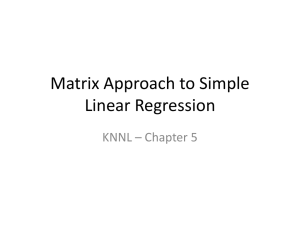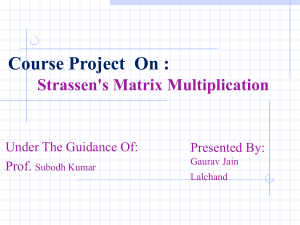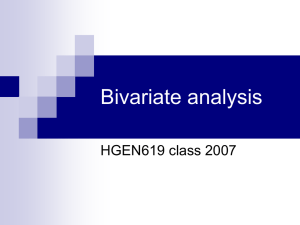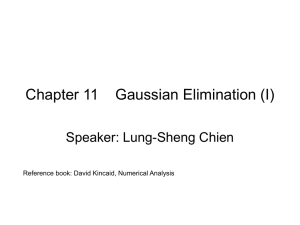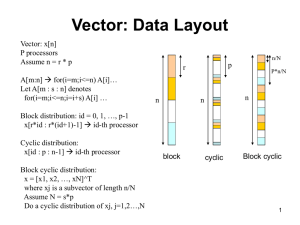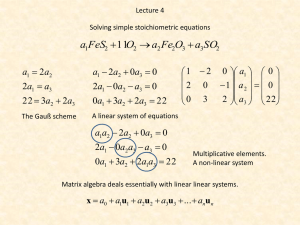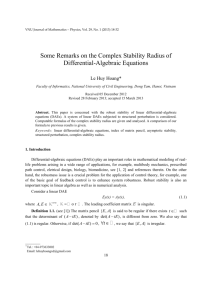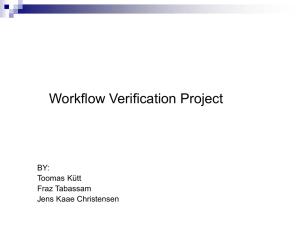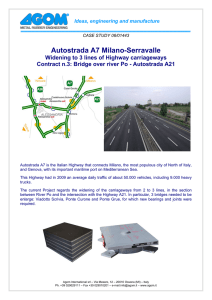Linear and multiple regression
advertisement
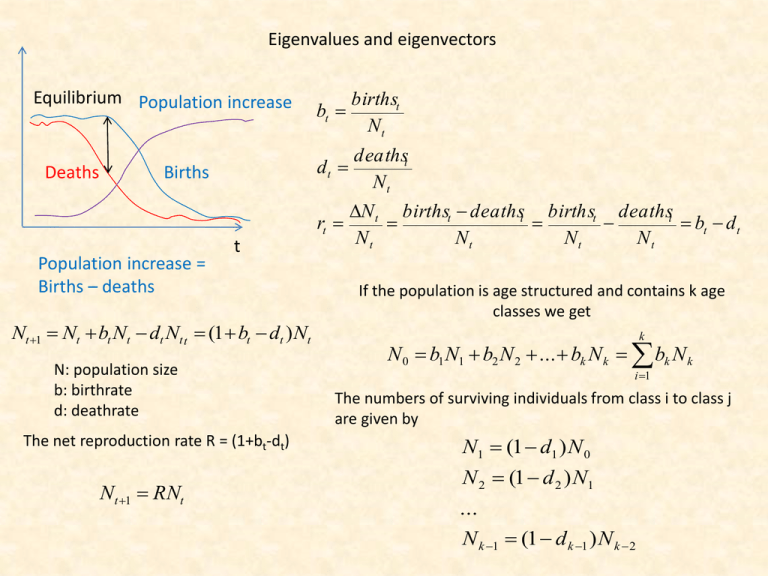
Eigenvalues and eigenvectors
Equilibrium Population increase
Deaths
Births
Population increase =
Births – deaths
t
Nt 1 Nt bt Nt dt Nt t (1 bt dt ) Nt
N: population size
b: birthrate
d: deathrate
The net reproduction rate R = (1+bt-dt)
Nt 1 RNt
bt
birthst
Nt
dt
deathst
Nt
rt
N t birthst deathst birthst deathst
bt d t
Nt
Nt
Nt
Nt
If the population is age structured and contains k age
classes we get
k
N 0 b1 N1 b2 N 2 ... bk N k bk N k
i 1
The numbers of surviving individuals from class i to class j
are given by
N1 (1 d1 ) N 0
N 2 (1 d 2 ) N1
...
N k 1 (1 d k 1 ) N k 2
Leslie matrix
Assume you have a population of organisms that is age structured.
Let fX denote the fecundity (rate of reproduction) at age class x.
Let sx denote the fraction of individuals that survives to the next age class x+1 (survival rates).
Let nx denote the number of individuals at age class x
We can denote this assumptions in a matrix model called the Leslie model. We have w-1 age classes,
w is the maximum age of an individual.
L is a square matrix.
k
N b1 N1 b2 N 2 ... bk N k bk N k
i 1
N1 (1 d1 ) N 0
N 2 (1 d 2 ) N1
...
N k 1 (1 d k 1 ) N k 2
n0
n1
N t n2
...
n
w 1
Nt 1 LNt
f 0 f1 f 2
s0 0 0
0 s
0
1
L
0 0 s2
... ... ...
0 0 0
f3
...
0
...
0
0
...
...
...
...
0
sw 2
fw 1
0
0
0
0
0
Nt 1 Lt N0
Numbers per age class at time t=1 are the dot product of the Leslie matrix with the abundance
vector N at time t
n0
f 0 f1 f 2 v
n1
s0 0 0 v
n
0 s
0
1
2
...
0 0 s2
... ... ...
...
n
w 1 t 1 0 0 0 v
f3
0
0
...
...
...
0
...
...
...
0
sw 2
fw 1 n0
0 n1
0 n2
0 ...
0 ...
0 nw 1 t
The sum of all fecundities gives
the number of newborns
n0s0 gives the number of
individuals in the first age class
Nw-1sw-2 gives the number of
individuals in the last class
The Leslie model is a linear approach.
It assumes stable fecundity and mortality rates
The effect pof the initial age composition disappears over time
Age composition approaches an equilibrium although the whole
population might go extinct.
Population growth or decline is often exponential
An example
Age class
1
2
3
4
5
6
7
Generation
0
1000
2000
2500
1000
500
100
10
N0
L
1000
2000
2500
1000
500
100
10
0
0.4
0
0
0
0
0
0.5
0
0.8
0
0
0
0
1.2
0
0
0.5
0
0
0
1.5
0
0
0
0.3
0
0
1.1
0
0
0
0
0.1
0
0.2
0
0
0
0
0
0.004
0.005
0
0
0
0
0
0
1
2
3
4
5
6
7
8
6070.05 4335.002 3216.511
3709.4 3822.356 3338.88 3195.559 3199.811
400 2428.02 1734.001 1286.604 1483.76 1528.942 1335.552 1278.224
1600
320 1942.416 1387.201 1029.284 1187.008 1223.154 1068.442
1250
800
160 971.208 693.6003 514.6418 593.504 611.5769
300
375
240
48 291.3624 208.0801 154.3925 178.0512
50
30
37.5
24
4.8 29.13624 20.80801 15.43925
0.4
0.2
0.12
0.15
0.096
0.0192 0.116545 0.083232
9
3037.552
1279.924
1022.579
534.2208
183.4731
17.80512
0.061757
10
2873.77
1215.021
1023.939
511.2894
160.2662
18.34731
0.07122
10000
100
10
6
1000
Abundance
At the long run the
population dies out.
Reproduction rates
are too low to
counterbalance the
high mortality rates
1
2
3
4
5
1
0.1
7
0.01
0
5
10
15
Time
20
11
2783.134
1149.508
972.0165
511.9697
153.3868
16.02662
0.073389
12
2681.059
1113.254
919.6063
486.0083
153.5909
15.33868
0.064106
Important properties:
1. Eventually all age classes
grow or shrink at the
same rate
2. Initial growth depends on
the age structure
3. Early reproduction
contributes more to
population growth than
25
late reproduction
Leslie matrix
fk
0
0
0
0
0
n1
n2
N t n3
...
nk
10000
100
1
2
3
4
5
10
6
1000
Nt 1 LNt
Nt 1 L N0
t
Abundance
b1 b2 b3 b4 ...
...
d1 0 0 0
0 d
0 0
...
2
L
...
0 0 d2 0
... ... ... ... ...
0 0 0 0 d
k 1
1
0.1
7
0.01
0
5
10
15
20
Time
Does the Leslie approach predict a stationary point where population abundances doesn’t
change any more?
dN
0
dt
Nt 1 LNt Nt
We’re looking for a vector that doesn’t change direction when multiplied with the Leslie matrix.
This vector is called the eigenvector U of the matrix.
Eigenvectors are only defined for square matrices.
LU U
LU U 0
[L I ]U 0
I: identity matrix
25
The insulin – glycogen system
At high blood glucose levels insulin stimulates glycogen synthesis and inhibits glycogen breakdown.
dN
fN g
dt
N
g
Ce ft
f
At equilibrium we have
fN g 0
N
f
1
g
0
The change in glycogen concentration can be
modelled by the sum of constant production
and concentration dependent breakdown
fN g 0
f
T
N 1T 0 0
1 N 1
g
1 N 2 f
2
N
g 0
1
N
0
2
N
N 2 1 0 f
1
0
0
1
g
0
The vector {-f,g} is the eigenvector of the dispersion matrix and gives the stationary point.
The value -1 is called the eigenvalue of this system.
How to transform vector A
into vector B?
Y
XA B
2 1 7
1
1
.
5
2
.
5
3 9
B
Multiplication of a vector with a
square matrix defines a new
vector that points to a different
direction.
The matrix defines a
transformation in space
A
The vectors that don’t change during
transformation are the eigenvectors.
X
XA A
Y
In general we define
XU U
B
A
XA B
X
Image transformation
X contains all the information necesssary
to transform the image
U is the eigenvector and the
eigenvalue of the square matrix X
XU U XU U 0
XU IU 0
[ X I]U 0
[ X Λ]U 0
The basic equation
XU U
a11
a21
...
a
m1
a11
a21
...
a
m1
a12
a22
...
am 2
a12
a22
...
am 2
... a1n u1
u1
... a1n u1
u1
...
... ... ...
u
... amn un
n
... a1n u1 0
... a1n u1 0
... ... ... ... ...
... amn un 0 0
... 0 u1
... 0 u1
... ...
... un
The matrices A and L have the same properties. We
have diagonalized the matrix A.
We have reduced the information contained in A
into a characteristic value , the eigenvalue.
a11 a12 u1
a21 a22 u2
a11 a12 u1
u1
a21 a22 u2
u2
v1 1 0 u1
v2 0 2 u2
v1
u
L 1
v2
u2
v1
v2
A nxn matrix has n eigenvalues and n eigenvectors
Symmetric matrices and their transposes have identical eigenvectors and eigenvalues
Eigenvectors of
symmetric
matrices are
orthogonal.
a11
a21
v1
v2
a21 u1
u a
u 1 ; 11
a22 u 2
u 2 a21
T
a11
a21
a21 u1 v1 u1
v
u u 1
a22 u 2 v2 u 2
v2
T
a11
a21
a21 y1
u1
v
a22 y2
u2
T
a11
a21
a21 u1 u1
a22 u 2 u 2
u1
u2
v1
v2
a21 v1
v
v 1
a22 v2
v2
v
u 1
v2
T
T
T
T
T
T
u1
u2
v1
v2
a11
a21
a21 v1
a22 v2
u1
u v
v 1 1 u (v1u1 v2u 2 ) v (v1u1 v2u 2 )
u2
u 2 v2
u1 v1
(v1u1 v2u 2 ) 0 0
u 2 v2
uv
How to calculate eigenvectors and eigenvalues?
[A i I] ui 0
The equation is either zero for the trivial case u=0 or if [A-I]
=0
2
1
2 1
1 0
0
0
3
4
3 4
0 1
(2 )(4 ) 3 1 1; 1 5
(2 )u1 u 2 0
1 u1
2 1
1 0 u1
2
1 1
0
0
u
u
u
3
4
0
1
3
4
3u
(4
)u
0
2
2
1 3
1
2
A ui i ui
2
3
2
3
1 1 1
1
1
4 1 1
1
1 1 5
1
5
4 3 15
3
The general solutions of 2x2 matrices
a12
a
A 11
a21 a22
Au u [ A I ]u 0
a11
a21
a12 0
u 0
a22 0
a11
a21
a12
0
a22
a11
a21
a11a22 (a11 a22 ) 2 a21a12 0
2 (a11 a22 ) a21a12 a11a22
a a
a a
( 11 22 ) 2 a21a12 a11a22 11 22
2
4
2
1, 2
a a
a a
11 22 a21a12 a11a22 11 22
2
4
2
Dispersion matrix
Distance matrix
a11
A
a21
a21
a11
1, 2 a11 a21
a12
0
a22
a21
a
A 11
a21 a22
2
1, 2
a a
a a
2
11 22 a21 a11a22 11 22
2
4
1, 2
a11 a22 4a21 (a11 a22 ) 2
2
2
2
a12
a
A 11
a21 a22
Au u [ A I ]u 0
a11 i
a21
a12 ui1
0
a22 i ui 2
a12 u1
a11
0
a22 u 2
a21
(a11 )u1 a12u 2 0
a21u1 ( a22 )u 2 0
This system is indeterminate
a11u1 a12u2 ... a1mum 0
a11 a12 ... a1m u1
a22 ... ... u2
a21u1 a22u2 ... a2 mum 0
a
A 21
0
... ... ... ... ...
...
a
am1u1 am 2u2 ... amm um 0
m1 ... ... amm um
a12u2 ... a1nun a11u1
u2
a21
a22 ... a1m
a22u2 ... a2 nun a21u1
u
a
... ... ... 3 u1 31
...
...
a ... ... a ...
m2
mm
am 2u2 ... amm um am1u1
um
am1
Matrix reduction
u11 1
a12 1
a11 1
0 a11 1 a12u12 0
a
a
22
1 u12
21
a12
u12
1 a11
u21 1
a12
a
A 11
a21 a22
Au u [ A I ]u 0
a11 i
a21
a12 ui1
0
a22 i ui 2
a21 (a22 2 )u22 0
u22
a11 ... a1m
A ... ... ...
a
m1 ... amm
a12
2 a22
Higher order matrices
Au u [ A I ]u 0
a1m u1
a11 ...
...
...
...
... 0
a
... amm um
m1
a1m
a11 ...
det ...
...
... 0
a
... amm
m1
m b1m 1 b2 m 2 ... bm 0
Characteristic polynomial
Eigenvalues and eigenvectors can only be computed analytically
to the fourth power of m.
Higher order matrices need numerical solutions
The power method to find the largest eigenvalue.
The power method is an interative process that starts from an initial guess of the
eigenvector to approximate the eigenvalue
Au u
Au0 0u0
Let the first component u11 of u1 being 1.
Au 1u
Rescale u1 to become 1 for the first component. This gives a
second guess for .
Au2 2u2
Repeat this procedure until the difference n+1 – n is less than a
predefined number e.
1
1
A
4
-2
2
X0
X1
1
1
1
u0
X2
5
-1
3
u1
1
1
1
0
u2
1
1
1
X3
X4
X5
X6
X7
X8
4.6 4.565217 4.561905 4.561587 4.561556 4.561553 4.561553
-1.4 -1.43478
-1.4381 -1.43841 -1.43844 -1.43845 -1.43845
2.6 2.565217 2.561905 2.561587 2.561556 2.561553 2.561553
u3
u4
u5
u6
u7
u8
1
1
1
1
1
1
1
1
-0.2 -0.30435 -0.31429 -0.31524 -0.31533 -0.31534 -0.31534 -0.31534
0.6 0.565217 0.561905 0.561587 0.561556 0.561553 0.561553 0.561553
1
1
0
0
0
2
5
3
4
5
6
7
8
4.6 4.565217 4.561905 4.561587 4.561556 4.561553 4.561553
Having the eigenvalues
thew eigenvectors come
immediately from solving
the linear system
a11 1
a21
...
a
m1
a12
a22 2
...
...
u1
...
... u2
0
...
... ...
... amm m um
...
a1m
using matrix reduction
Some properties of eigenvectors
If L is the diagonal matrix of
eigenvalues:
The eigenvectors of symmetric
matrices are orthogonal
ΛU UΛ
A( sym m etric) :
AU UΛ AUU1 A ULU 1
U' U 0
Eigenvectors do not change after a
matrix is multiplied by a scalar k.
Eigenvalues are also multiplied by k.
The product of all
eigenvalues equals the
determinant of a matrix.
det A i 1 i
[ A I ]u [kA kI ]u 0
The determinant is zero if at
least one of the eigenvalues is
zero.
In this case the matrix is
singular.
If A is trianagular or diagonal the
eigenvalues of A are the diagonal
entries of A.
n
A
2
3
3
-1
2
4
3
-6
-5
5
Eigenvalues
2
3
4
5
Page Rank
p A dpB
k
k BA
k
1 d
dpC CA dpD DA
cB
cC
cD
N
pB dpA
k
k AB
k
1 d
dpC CB dpD DB
cA
cC
cD
N
pC dpA
k AC
k
k
1 d
dpB BC dpD DC
cA
cB
cD
N
pD dpA
k
k AD
k
1 d
dpB BD dpC CD
cA
cB
cC
N
In large webs (1-d)/N is very small
k
k
k
p A 0 p A dpB BA dpC CA dpD DA
cB
cC
cD
pB dpA
k
k AB
k
0 pB dpC CB dpD DB
cA
cC
cD
k
k
k
pC dpA AC dpB BC 0 pC dpD DC
cA
cB
cD
k
k
k
pD dpA AD dpB BD dpC CD 0 pD
cA
cB
cC
0
k AB
d c
A
k
d AC
cA
k
d AD
cA
d
k BA
cB
0
k BC
cB
k
d BD
cB
kCA
cC
k
d CB
cC
d
d
0
d
k DA
cD
k
d DB
cD
k
d DC
cD
d
kCD
cC
0
p A p A
pB pB
pC pC
p p
D D
A standard eigenvector problem
Pu u
The requested raking is simply contained in the
largest eigenvector of P.
A
B
C
D
0
kA
d c
A
d kA
cA
k
d A
cA
d
kB
cB
0
kB
cB
k
d B
cB
kC
cC
k
d C
cC
d
d
0
d
kC
cC
kD
cD
k D p A p A
d
cD pB pB
k D pC pC
d
cD p p
D D
0
d
0
0
0
1
p A
0
.
15
1
0
.
15
0
.
15
/
2
pB
0
0.15
1
0.15 / 2 pC
0
p
0
0
1
D
1 0.85
1
0
.
85
1
4 1 0.85
1 0.85
The data points of
the new system are
close to the new xaxis. The variance
within the new
system is much
smaller.
Principal axes
u2
15
10
u1
10
5
5
u2
-8
-6
-4
-2 -5 0
2
4
6
8
10
-10
-8
-6
-4
-2
0
2
4
6
8
10
-5
-10
-15
0
Y
Y
0
-10
u1
-10
X
X
15
Y
10
-1 0
-8
-6
Principal axes define the longer and shorter
radius of an oval around the scatter of data
u1
points.
The quotient of longer to short principal axes
measure how close the data points are associated
(similar to the coefficient of correlation).
u25
0
-4
-2
-5 0
-1 0
-1 5
2
4
6
8
X
V(u1;u 2) (X( X ;Y ) M( X ;Y ) )U
10
The principal axes span a new Cartesian system .
Principal axes are orthogonal.
Major axis regression
15
The largest major axis defines a regression
line through the data points {xi,yi}.
u1
10
The major axis is identical with the
largest eigenvector of the associated
covariance matrix.
The length of the axes are given by the
eigenvalues.
The eigenvalues measure therefore the
association between a and y.
5
u2
Y
0
-10
-8
-6
-4
-2 -5 0
-10
-15
X
2
4
6
8
10
The first principal axis is
given by the largest
eigenvalue
(D I)U 0
Major axis regression minimizes the Euclidean
distances of the data points to the regression line.
2
s X2 sY2 4s XY
(s X2 sY2 ) 2
1, 2
2
u 21 a1
u 2
12
u 22 2 a22
a12
u 22
2 a22
s X2
D Σ
s XY
u21 1
u22
mMAR
s xy
sy2
s XY
2
sY
s xy
u 22
u 21 s y 2
bMAR Y m X
The relationship between ordinary least square (OLS) and major axis (MAR) regression
s
r XY
s X sY
mOLS
mOLS r
s XY
2
sX
sY
sX
mMAR
mMAR r
2
mMAR mOLS
sX
sY 2
s XY
sY 2
s X sY
sY 2
Going Excel
X
Y
Covariance matrix
0.7198581
0.2683467
0.9514901
0.8280125
0.4483117
0.9386594
0.301201
0.4835976
0.7188817
0.7992589
0.3955747
0.802986
0.5685275
0.0697029
0.3099076
0.9044138
0.3853803
0.2352667
0.8249179
0.8661037
0.066128
2.486935
0.351561
2.705939
2.097096
0.87799
2.705279
0.960431
1.898561
1.956716
2.734179
0.958425
2.721408
1.25693
0.296154
0.688048
2.466684
0.981417
0.945944
2.378733
2.56935
0.603999
0.084878 0.23295
0.23295 0.791836
3
2.5
0
0
2
Y
Eigenvalues
0.015021
0.861692
y=3.3347-0.2379
1.5
y = 2.8818x + 0.0185
1
Eigenvectors
0.957858 0.287241
-0.28724 0.957858
0.5
0
0
Eigenvectors
0.979137
0.2032
-0.2032 0.979137
a
b
Parameters
3.334687
-0.23791
Values to draw the MAR regression
0.1 0.095561
0.9 2.76331
0.2
0.4
0.6
X
0.8
1
Errors in the x and y variables cause OLS regression to predict lower
slopes. Major axis regression is closer to the correxct slope.
Y
1
=3*A4+2
1
2
3
4
5
6
7
8
9
10
11
12
13
14
15
16
17
18
19
20
21
5
8
11
14
17
20
23
26
29
32
35
38
41
44
47
50
53
56
59
62
65
=A4+A4*(LOS =B4+B4*(LOS
()-0.5)
()-0.5)
0.620370962
1.405829923
3.932365359
3.369965031
6.754318881
3.140987171
4.848193641
11.07692858
10.48809173
5.174301246
5.632905042
13.32938498
16.94257054
15.78715334
21.75787273
12.77137686
13.25068353
22.70011271
25.34824478
26.61513272
24.21743343
Covariance matrix
4.053401137
71.08896 93.07421
5.955994942
93.07421 264.3759
14.33527103
10.78551619
Eigenvalues
16.24109695
33.55803
27.95607099
301.9068
25.99785179
36.23837193
30.37969645
Eigenvectors
46.52139803
0.927438 0.373977
34.70506056
-0.37398 0.927438
44.35231794
25.73278151
25.52100704
Parameters
52.94515263 a
2.479933
48.07135318 b
8.847974
38.67108652
28.7831935 Values to draw the MAR regression
40.06533423
0.5 10.08794
60.76764637
27 75.80618
57.47387651
Y
X
80
70
60
50
40
30
20
10
0
The MAR slope is always steeper than the OLS slope.
If both variables have error terms MAR should be
preferred.
y=2.48+8.85
y=3+2
y = 1.37x + 15.86
0
10
20
30
X
Major axis
regression
(MAR)
Ordinary
least squares
regression
(OLS)
MAR is not stable after rescaling of only one of the variables
34
60
92
1
18
144
50
114
64
102
1
12
11
1
114
1
2
119
85
2
143
35
169
50
97
0
2
Latitude
of capitals
(decimal
degrees)
41.33
42.5
48.12
37.73
39.55
53.87
50.9
43.82
51.15
42.65
27.93
49.22
41.92
35.33
45.82
37.1
35.15
50.1
55.63
36.4
59.35
62
60.32
48.73
52.38
36.1
37.9
Years
below
zero
0.094444
0.166667
0.255556
0.002778
0.05
0.4
0.138889
0.316667
0.177778
0.283333
0.002778
0.033333
0.030556
0.002778
0.316667
0.002778
0.005556
0.330556
0.236111
0.005556
0.397222
0.097222
0.469444
0.138889
0.269444
0
0.005556
400
Covariance matrix
80.38689 420.4235
420.4235 3803.503
Covariance matrix
80.38689 1.167843
1.167843 0.029348
y=8.97-350.6
300
D
41.33
42.5
48.12
37.73
39.55
53.87
50.9
43.82
51.15
42.65
27.93
49.22
41.92
35.33
45.82
37.1
35.15
50.1
55.63
36.4
59.35
62
60.32
48.73
52.38
36.1
37.9
Days
below
zero
200
100
Eigenvalues
33.50203
3850.388
y = 5.32x - 179.4
0.012379
80.40386
0
0
Eigenvectors
0.993839 0.110831
-0.11083 0.993839
a1
b1
Parameters
8.96715
-350.55
Values to draw the MAR regression
1 -341.583
80 366.8216
MAR
a1/a2
OLS
a1/a2
Days/360
OLS regression retains the
correct scaling factor, MAR
does not.
0.014528 0.999894
-0.99989 0.014528
a2
b2
Parameters
0.01453
-0.48722
0.8
40
L
60
80
y=0.0145-0.487
0.6
y = 0.0148x - 0.498
0.4
-0.47269
0.675179
20
1
D
Latitude
of capitals
(decimal
degrees)
0.2
0
617.1465
359.4595
0
20
40
L
60
80
MAR should not be used for comparing slopes if variables have
different dimensions and were measured in different units, because
the slope depends on the way of measurement.
If both variables are rescaled in the same manner (by the same
factor) this problem doesn’t appear.
Scaling a matrix
AU UL
A U U L A U L U 1
A n (U L U 1 )(U L U 1 )(U L U 1 )...
A n U (L U 1 U...) U 1 U L n U 1 U in I n U 1 U in U 1
A n U in I n U 1
A n U in U 1
A simple way to take the power of a square matrix
The variance and covariance of data according to the principal axis
Σ ( x; y )
11 ... 1m
1
... ... ...
( X M )T ( X M )
n 1
m1 ... mm
y
(x;y)
u1
u2
V(u1;u 2) (X( x; y ) M( x; y ) )U
The vector of data points in the
new system comes from the
transformation according to the
principal axes
x
Σ (u1;u 2)
1
1
1
V T (u1;u 2 ) V(u1;u 2)
U T ( X M )T ( X M ) U
UT Σ ( x; y ) U
n 1
n 1
n 1
Eigenvectors are normalized to the length of one
k2 uk T ( x; y )uk uk T k uk k uk T uk k
The variance of variable k in the new
system is equal to the eigenvalue of the kth
principal axis.
The eigenvectors are orthogonal
jk u j T ( x; y )uk u j T k uk k u j T uk 0
The covariance of variables j and k in the
new system is zero. The new variables are
independent.

